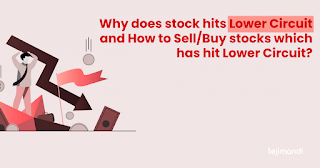Why do stocks hit the lower circuit and how do sell/buy stocks, which have hit the lower circuit?
Market
participants anticipate volatility because the stock market is notorious for
it. In fact, making money off short- and long-term price changes in stocks is a
key principle behind the very idea of the stock market.
However,
what if this volatility exceeds the range that can be controlled, causing
abnormal stock movements and unheard-of gains or losses? By putting price
circuits on equities, SEBI has implemented methods to control price volatility.
Circuits
prevent investors from being caught off guard by any abrupt, unexpected price
changes by limiting the movement of stock price beyond a certain permitted
level.
What is a lower circuit?
A lower
circuit is put in place to restrict a continuous spiral down of a stock’s price
beyond a predefined percentage. The lower circuit defines the lowest tradable
price for a stock in a particular trading session. The stock will be ‘frozen’
at the lower circuit until the time there are no fresh buyers who come to the
rescue.
When a stock
hits its lower circuit, there will only be sellers and no buyers, but because
the stock is already trading at the lower circuit, no more sell orders are
entertained. However, buy orders will be executed without any hindrance because
the lower circuit is put in place to restrict further selling, not buying.
Read More - Teji
Mandi also offers referral incentives to its subscribers, all you need to do is
refer Teji Mandi App
to your contacts and ask them to use your referral code while making the
subscription payment.
Why do stocks hit the lower circuit?
There may be
varied reasons for stock to slump; it could be a domino effect of index-wide selling
or industry-wide selling.
It could be
because of a negative news development about a particular stock, like the exit
of senior key management personnel, or disruption of a potential deal for the
company.
Who sets the lower circuit and the
circuit limit?
We just saw
in the above example that the lower circuit for ADANI GREEN is set at 5%. But
that’s not the case with all the stocks. The minimum permissible limit for the
stock is decided by SEBI based on its previous day’s closing.
The lower
circuit for different stocks may vary from 2-20% and is fixed by SEBI
considering the volume, liquidity, and the category of the stocks. These
circuit levels are not permanent and can be altered subject to periodical
review. For liquid stocks, the circuit is hiked and for stocks, with dried up
liquidity circuit is lowered.
Learn more
about the Regulatory Bodies in the Indian stock
market in our blog here




Comments
Post a Comment